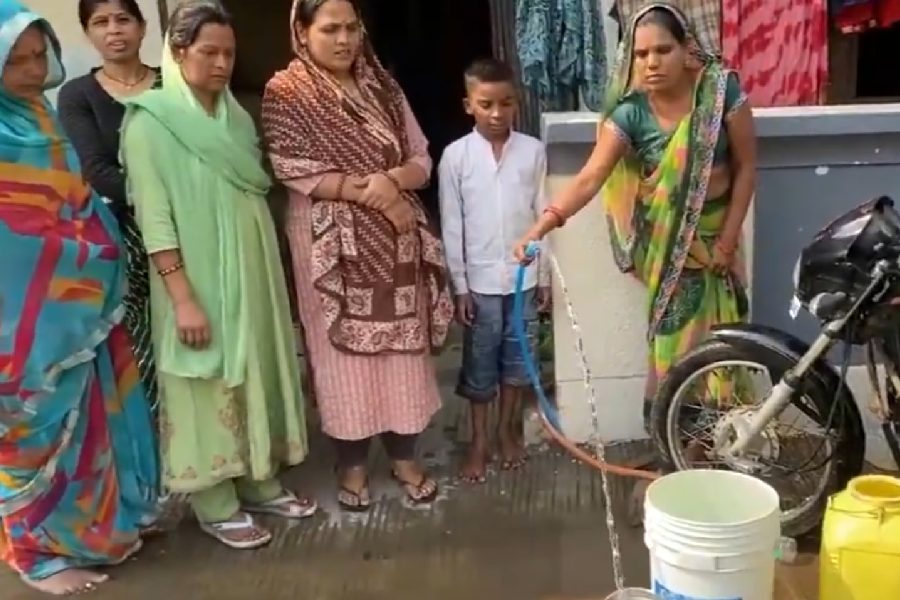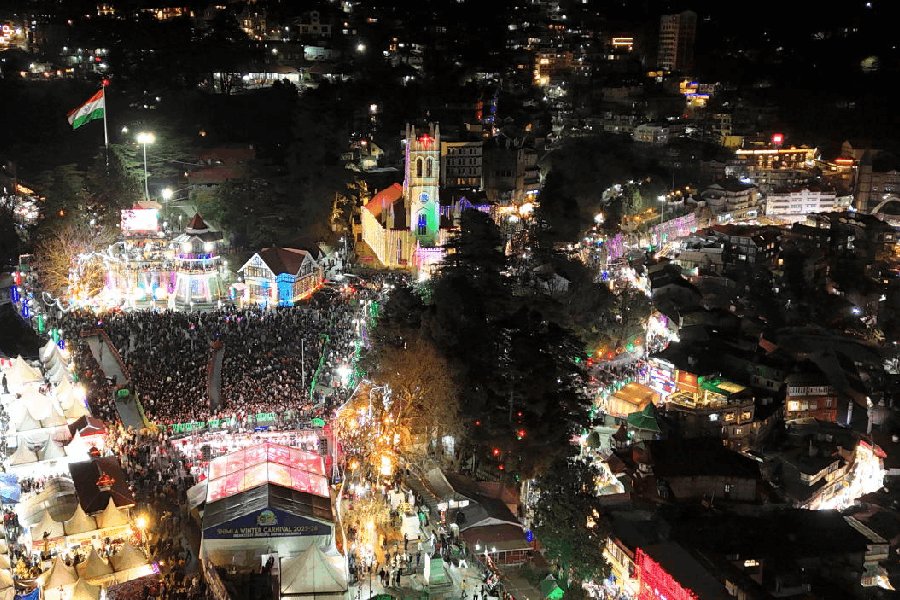 |
| Pictures show the bare-knuckle battle being waged by the personnel of the Border Roads Organisation to clear the sole highway in North Sikkim, the district worst affected by the quake. Dwarfed by a denuded valley and a green canopy, a task force member picks his way through a jagged carpet that buried the highway at Theeng, 35km from Gangtok. Multiple landslides on the highway have to be cleared for rescue teams to reach Chungthang, Lachen and Lachung, areas feared to have been badly affected. |
Gangtok, Sept. 21: Nine villages with a combined population of 1,000 were out of the reach of the rescue effort in North Sikkim till this evening, injecting a fresh sense of urgency into a task force blasting past and working around boulders blocking roads in the region.
The cut-off villages are located in Dzongu, the protected area of the Lepchas, the indigenous tribal community of Sikkim. The villages have been identified as Shipgyer, Bey, Saffo, Salem, Payel, Sakyong, Pentong, Lingzy and Tholung which fall in the upper Dzongu region opposite Chungthang valley.
Construction workers from elsewhere make up between 40 and 50 per cent of the 1,000-strong population in these villages — a feature that has implications for states such as Bengal from where people go to these sparsely populated regions to work.
One such tragedy emerged today with the announcement that 17 workers of Teesta Urja Ltd, a company implementing a 1,200MW hydel power project in North Sikkim, had died in the quake. A company statement said the workers were killed by falling boulders at different spots, not because of tunnel collapses.
An electrician in his late thirties and from South 24-Parganas in Bengal, Pabitra Manna, was killed when his rented flat collapsed in Chungthang in North Sikkim. He was working for a construction company. So far, six persons from Bengal had died in Sikkim.
The workers were among the 70 casualties reported till this evening in Sikkim alone. Unofficial reports put the Sikkim toll at 73, taking the overall figure within and outside the country to 116.
Sikkim chief minister Pawan Chamling put the loss from the quake at Rs 1 lakh crore.
Rescue and relief teams are still to reach several villages in North Sikkim, the largest but least populated of the four districts in Sikkim, although telecommunication facilities have somewhat improved in Mangan, the administrative headquarters of the district.
 |
 |
| The two pictures taken a little away from the rubble-strewn spot show the toil that goes into getting past one of the several boulders that are blocking the highway. A spike was wedged in and a rope was looped around it (above) so that the personnel could hold on and cross the stretch without slipping and sliding off into the treacherous ravines |
But beyond Mangan, the disruption is total. According to information pieced together from the army, the Border Roads Organisation and the Sikkim government, at least 13 areas in North Sikkim are cut off by multiple landslides.
The first three are Lachen, Lachung and Chungthang town along the North Sikkim highway. Around 200 metres of the highway has been washed away beyond Toong, 14km from Chungthang. However, since the army and the Indo-Tibetan Border Police (ITBP) are present in these locations, relief workers are not too alarmed about these areas.
What they are concerned about are the nine villages in Dzongu. “A number of houses were washed away since the quake. We have sought the help of the army to drop food supplies and medicines. Our officials are reaching these isolated areas on foot to assess the damage. Two hundred members of the NDRF (the National Disaster Response Force) are also spreading out,” said Sikkim government spokesperson K.S. Topgay.
“Sixteen hundred kilos of rice were dropped in these villages by army choppers,” said Lt Gen. Vinod Bhatia, the core commander of 33 Corps. However, since the stretch is wide, it was not clear how many people could access the food.
A team of 1,200 (600 BRO personnel and as many labourers) is carrying out the back-breaking — and often cliff-hanging — work of battling the boulders that had lodged themselves in the middle of the highway between Mangan and Chungthang.
Nine excavators or bulldozers have been deployed to clear away the rubble and small rocks. Dynamite is being ignited and jackhammers are chiselling away to break the huge boulders into smaller pieces so that they can be swept away by the machines.
The BRO is facing a shortage of diesel, which is needed to fuel the machines and power the jackhammers. The organisation is planning to airlift diesel to these locations.
The extraordinary odds have prompted the government to waive formalities. Permission has been given to health workers and police assisting rescue operations to conduct “on-the-spot” post-mortem instead of carrying the bodies to the district hospital at Mangan.











